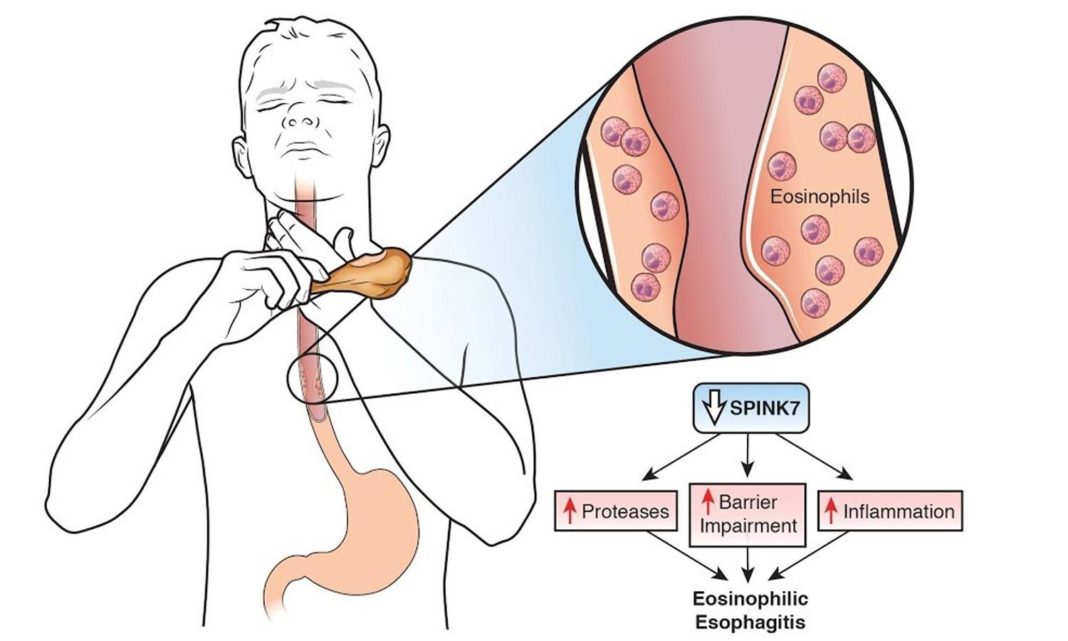When someone has eosinophilic esophagitis, the eosinophil (this is a type of white blood cell) builds up in the lining of the tube which connects the mouth to the stomach (esophagus). This buildup (which is a reaction to foods, allergens or acid reflux), can injure or inflame the esophageal tissue. The damaged esophageal tissue can lead to difficulty swallowing or it can cause food to get stuck when you swallow.
The eosinophilic esophagitis is a chronic immune system disease. This disease has been identified only in the past 2 decades, but nowadays it is considered as a major cause for digestive system (gastrointestinal) illness. Studies are still done and they will lead to revisions in the diagnosis and treatment of the eosinophilic esophagitis.
Symptoms

The signs and symptoms of the eosinophilic esophagitis are different in adults and children and they include:
- Adults:
- Backflow of undigested food (regurgitation)
- No response to gastroesophageal reflux disease (GERD) medication
- Upper abdominal pain
- Persistent heartburn
- Chest pain that is often centrally located and does not respond to antacids
- Food can ge stuck in the esophagus after swallowing (impaction)
- Difficulty swallowing (dysphagia)
- Children:
- Failure to thrive (poor growth, malnutrition and weight loss)
- No response to GERD medication
- Food can get stuck in the esophagus after swallowing (impaction)
- Difficulty swallowing (dyshpagia)
- Abdominal pain
- Vomiting
- Difficulty eating, in children
- Difficulty feeding, in infants
Causes
We know that eosinophils are normal type of white blood cells which are present in the digestive tract. When someone has eosinophilic esophagitis, then he or she has an allergic reaction to an outside substance. This reaction can happen as follow:
- Dysphagia and impaction: You can have difficulty swallowing (known as dysphagia) or the food can become stuck when you swallow (this is known as impaction).
- Damage to esophagus: The inflammation can lead to narrowing, scarring and formation of excessive fibrous tissue in the lining of the esophagus.
- Multiplication of eosinophalis: It is known that the eosinophils can multiply in the esophagus and this can produce a protein which causes inflammation.
- Reaction of the esophagus: It is known fact that the lining of the esophagus reacts to allergens, such as pollen or food.
- Additional symptoms: You can have other symptoms, such as stomach pain or chest pain.
In the past decade, the number of people who have been diagnosed with eosinophilic esophagitis is increasing. Firstly, it was thought that this is due to the increase in the awareness among doctors and the greater availability of tests. But, studies are suggesting that this disease is becoming increasingly common, parallel to increase in allergy and asthma.
Risk factors
Here are some factors which are increasing the risk of getting eosinophilic esophagitis:
- Age: In the past was thought that eosinophilic esophagitis is a childhood disease, but it is known that is common through adults. The symptoms of eosinophilic esophagitis can be different in children and adults.
- Allergies and asthma: You have increased risk to be diagnosed with eosinophilic esophagitis if you have a chronic respiratory disease, atopic dermatitis, asthma or if you have food or environmental allergies.
- Family history: Doctors say that the eosinophilic esophagitis can run the family (you have a genetic component). It is known that if your family members have eosinophilic esophagitis, then you have increased chances of getting it.
- Sex: It is noticed that eosinophilic esophagitis is more common in males than females.
- Season: You have increased chances of being diagnosed with eosinophilic esophagitis between the spring and fall which may be due to the higher levels of pollen and other allergens and people are more prone to be outdoors.
- Climate: Those people who live in a cold or dry climate are having more chances of getting to get eosinophilic esophagitis compared to people who live in other climates.
Complications
There are some cases in which the eosinophilic esophagitis can lead to complications like:
- Damage to esophagus: The inflammation of the esophagus, endoscopy can cause tears or perforation in the tissue which lines the esophagus. Tearing can happen in connection with retching that some people experience when the food gets stuck in the esophagus.
- Scarring and narrowing of the esophagus: This can make difficult to swallow and it is increasing chances that your food will get stuck.




